
A TRIP TO AFRICA
On my recent trip to Africa, where apart from having a holiday, I was also on the outlook for new fruits that may prove promising.
There are three different types of nuts, in particular, which in my belief are really outstanding, and could prove to become not only a new addition for the hobby gardener, but also profitable to be grown commercially.
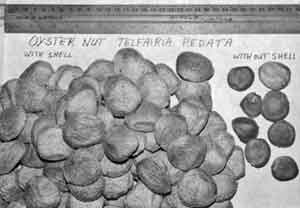 | Describing the first one, common name Oyster Nut - Botanical name Telfairia pedata. The oyster nut is a tall perennial climber with growth in the early stage somewhat resembling a common granadilla, the slender semi-woody stems reaching up to 50 ft and therefore requiring large trees to grow over for support. To build trellis supports is uneconomic. It is not a true nut, but belongs to the pumpkin family. Plants are entirely of one sex, (dioecious), which can only be determined when flowering commences 1½ to 2 years after germination. The female plants produce large ribbed gourds 30-50 cms long and 20-30 cms diameter. They weigh 15-30 lbs and contain up to 150 edible nuts. |
| Telfaria pedata |
The nuts are flat, about 1½" diameter and average 35 to 40 to the lb. Flowering to ripening time takes about 4½ months. Pollination is usually necessary where non-setting has occurred.
While it is a tropical plant, it has grown well in the 3,500 to 4,840 ft altitude range where light frost is experienced; however, choose a well-sheltered position and keep out of frost pockets. Not less than 70 cm rainfall is preferable. Plants have an economic life of 10 years or more.
SOIL REQUIREMENTS AND PREPARATION FERTILIZING SEED AND SEED TREATMENT PLANTING Place some bush wood alongside for the plant to climb up for an initial trellis. Plant growth is improved by being mulched with compost or trash. | 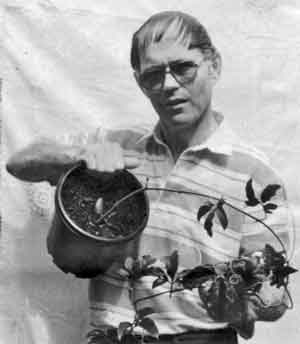 |
| Hans Muller holding an Oyster Nut Plant |
MANAGEMENT
Water at least twice a week to get young plants well established as quickly as possible in the dry season. Once through the rains, plants can stand the dry season without water. Excess plant growth should be cut back.
HARVESTING
As the gourds get ripe they fall away from the stem and the nuts embedded in a pulp are removed and washed clean. Spread out in the sun to dry and to become bleached.
No special storage conditions are required. Thoroughly dry nuts can be placed in boxes in a dry building until needed and will keep well for eight years or more. To open the nuts, cut along the edge of the shell which is best done with a secateurs then follow with a sharp taps until the top and bottom separate. The kernel can then be extracted. The nuts take the place of other edible nuts and can be used for dessert, confectionary and cooking.
YIELDS
Yields vary considerably according to climatic and soil conditions. One plant in East Africa covering an area of about 40 square meters produced 150 kilos of cleaned nuts in two years. Over one ton per acre yields occur in East Africa.
GRADING
It is preferable to keep nuts from small gourds separate from those of large ones, as there is an appreciable difference in size.
MARKETING
So far, nuts have been sold to provision merchants and through the Municipal Markets by weight-in-the-shell in Eastern Africa.
PESTS AND DISEASES
No pests or diseases have been recorded.
ANALYSIS
The kernel constitutes approximately 50 per cent of a nut weight. Oil content is 62 per cent or more. Protein content 26 per cent.
Since I read the story about them in my books, Edible Nuts of the World and Food Bearing Plants in Australia, I was most interested in obtaining some of these plants for the past three years. But however without success, as there seemed to be nobody around in Australia or the USA to have plants or seeds. I was trying to get some seeds from Africa, but they would never ship the seeds to me. This was one of my reasons for directing my holiday to Africa.
After travelling through several tropical African countries, I finally came to one supermarket where they had Oyster Nuts for sale in packets. At the same time I found that in some localities Oyster Nuts were being served in some restaurants. The oyster nuts I bought from the supermarket were 10 months old, and I shipped about 100 of these seeds to Australia, and one in ten seeds still germinated, which means that oyster nuts are viable for a long time.
The oyster nuts are very popular in their localities where they occur. I found that they are grown in private gardens and commercially.
I visited a place where they are commercially grown and collected some first-hand information, which were in some cases contradictory to what I read in the Book of Food Bearing plants in Australia, where it states fruits are usually borne in the 7th year, which is wrong. It takes only 1½ to 2 years. Also the nuts take 3 - 5 weeks to germinate, and not in one week as stated in the book, and the quantity of nuts produced in each gourd is around 100-150 nuts per gourd and not up to 400. I think the story in this book must have been based mainly on guess-work, as there is so little known about this nut.
I happened to be at the Oyster Nut farm during the time when the large gourds were ripening, which is during the month of February. However, I was unable to take photos of the large gourds because the vines are trained to grow over large trees, and all the action is happening on top of the tree.
When the gourds are ripe, they fall to the ground and burst open, then they are taken to a nearby river and washed free of pulp. The trees these vines creep on usually die after a few years.
I have eaten numerous oyster nuts, and in my opinion they are a high-quality nut with good flavour, tasting similar to hazel nut, and I was told at the nut farm that the flavour improves with age. These nuts taste very good in a raw state. I am sure it is one of the rare quality nuts, a collector's item.
The oyster nut plants I have growing in my back garden in Sydney are very fast-growing and up to now are unaffected by the cooler weather we had at night.
There were several oyster nut plants growing at the International Air Terminal in New Zealand. All were killed by the cold weather except one male plant which is still growing there, at the present time.
As I was told by the Oyster Nut Farm that they can take a light frost, there is no doubt in my mind that they can succeed in warmer parts of New South Wales and Queensland as long as they are provided with fertile soil and sufficient water.
I hope that this information will assist all those who are interested in hobby gardening and interesting quality rare fruits, as well as those who want to try them out on a commercial basis.
Note from Pat Scott:
Quite a few people in Australia would like to try to get this. A few plants were grown about 10 years ago in Geraldton, WA. I have corresponded with the person who grew them. She had started 3 seedlings, but at the time of writing, 2 had died. The third one was still alive because it was growing near a leaky tap so they have a high need for water.
There are a number of problems about growing them. The vines are very large, typically allowed to climb trees, and they usually have a short life span, just a year or two, seemingly because the roots get infected with mould.
The most serious problem, however, is their sex life: plants are either male or female, so you would have to grow a number of them to ensure you could produce seeds. As well, even though you might have both male and female, they may turn out to be incompatible with each other.
In their native area in Africa, people treat the plants as annuals, allowing them to die in the dry season, and starting out with seeds again in the wet season. This means that there always needs to be a good, local supply of seeds. So, sorry to say, you are not likely to find any such supply in Australia.
The following two nut trees have the botanical names of Ricinodendron heudelotii and Ricinodendron rautanenii, commonly known by the Africans under the name of Mungongo nut.
It is a popular edible nut amongst the Africans.
I have also eaten some of these nuts raw and found them to have a good flavour and the same in size to hazel nuts.
The nuts are surrounded by a thinner inner shell which is easy to crack. This shell is surrounded by a thicker, harder shell which is more difficult to crack, which is probably the reason why the Africans roast the nuts in fire to make it easier to crack the thicker part of the shell. The thicker part of the shell has an outer green, fleshy layer which is easily removed and is said to be eaten by some animals.
It is essential to have male and female trees in order to get fruits.
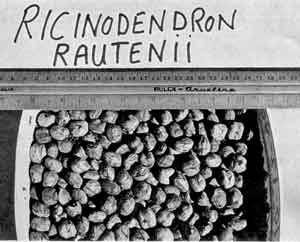 | Ricinodendron heudelotii grows in Equatorial Africa and Ricinodendron rautanenii is very common in the Victoria Falls area of Africa, where it is commonly used as a street tree. The soil in the region where it is growing is red, sandy. There is only a little rainfall during the summer months with virtually no rain during the rest of the year. The temperature in summer time is in the mid-30s Celcius. This would probably make it a suitable tree for Australia where there is similar climate and low rainfall. It possibly could prove to be an easy-to-maintain tree; once planted in during the rainy season, it will be established before the dry season begins. This tree is very fast-growing and produces a soft wood which is extremely light and somewhat identical to the poplar. The wood is used a lot to make the african drums. |
| Ricinodendron rautanenii |
I came across one of these huge trees which was attacked by termites, and half of the tree fell to the ground, and this part of the tree was cut up in sections of 1 to 2 metres in length, just lying on the ground. All these sections started to grow roots and shoots from small and large diameter cuttings, which shows how easy it must be to grow these trees from cuttings.
Both varieties I have growing in my glasshouse. The seeds, after the thicker shell was removed, germinated very rapidly in 1 to 2 weeks. The main difference between these two varieties is that they come from two different regions, and in the case of Ricinodendron heudelotii, has a thicker inner shell which is more roundish and even the leaves are more pointy. Ricinodendron heudelotii comes from the wetter regions of Equatorial Central Africa.
In the case of Ricinodendron rautanenii seeds, the inner shell is more or less uneven and is thin enough to be cracked by the fingers, the leaves are less pointy and more pale green in colour.
There is no doubt in my mind about the quality of these two nuts; they are really good eating in a raw state, and could prove to be a good commercial nut with little hassle to grow.
I have not seen any of these trees that were sick-looking, and all seem to have a heavy crop of nuts. However I have seen a few major trees which were attacked by wood borers and termites. It surely must be a worthwhile tree to try out in Australia. In Africa, I have seen all these trees growing wild, which means that they probably need very little attention, if any.
I have also visited many African market places and have seen many fresh fruit types with two in particular which took my attention for being a very interesting fruit as well as good eating.
One of these has the common name 'Snot Apple', Botanical name Azanza garckeana.
The fruit is a woody capsule about 4 cm in diameter, clearly divided into five sections, brownish in colour when mature. Despite their hard woody nature, the fruits are edible. The whole fruit except the seeds are chewed like chewing gum, and this fruit when it becomes moist, softens up and releases over a period of 10 to 15 minutes a very sweet, glutinous slime which appears to be sweeter than dates and very agreeable to taste. There is no doubt that these hard fruits will store for a long time in a dry state. It has large blossoms looking similar to the Hibiscus flower. Only one tree is required for fruiting. The fruit is popular with the Africans. Most market places where this fruit is available one can see Africans enjoying chewing the fruit. The seeds took 4 weeks to germinate, and are slow-growing. | 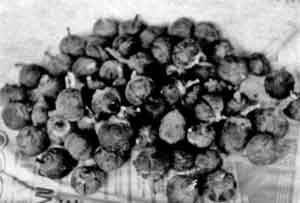 |
| Azanza garckeana |
Another very interesting tree is botanical name Strychnos pungens also commonly available from the markets. It is a small tree 3 to 7 metres in height. Leaves are opposite.
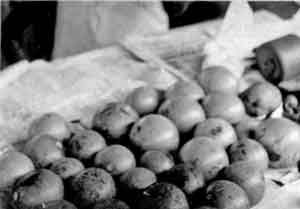 | Fruits are collected by the Africans from the forest. It has a round, hard, woody shell up to 12cm in diameter. When ripe, it is yellow in colour. The Africans eat the fruits by making a small hole into the hard shell, which is also easy to crack, and then they suck the juice out of it. After this they break the shell open and eat the juicy flesh surrounding the seeds. These fruits when opened up have an overpowering strong smell which is pleasant. If left inside, it will perfume the whole house. The juice and fruit have a very strong taste. I have tried this fruit and found it quite pleasant to eat. The Africans go mad over this particular fruit. The only inedible parts of the fruit are the seeds, which are pointy on one end and about 8 to 10 mm long, and the woody shell which is about 3 - 4 mm thick. Seeds took about 4 weeks to germinate and plants are growing fast. |
| Strychnos pungens |
Most of the African fruits which appear in market places are ripening from the beginning of October to the end of December, with very little fruit ripening the rest of the year.
I have not noticed many Africans growing their indigenous fruits in home gardens or on farms. They seem to be only collected from the forests.
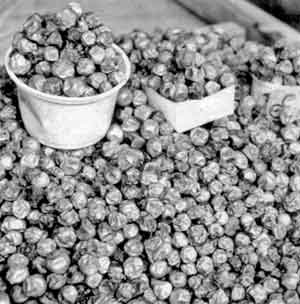 | 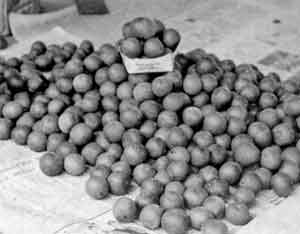 |
| An African fruit sold in markets with the name of Masawu. Fruit is sweet-sour. | An African fruit sold in markets with the name of Mazhanje. The fruit is sweet and juicy. |
DATE: May 1988
* * * * * * * * * * * * * * *
